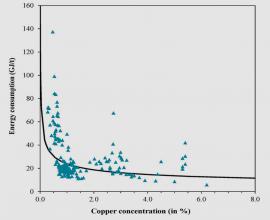MEDEAS partners from CIRCE have just published a scientific article in the MDPI Resources Journal, entitled “Decreasing Ore Grades in Global Metallic Mining: A Theoretical Issue or a Global Reality?”.
Demand for the main metals that modern society needs to produce goods has increased dramatically over the past few decades, thereby increasing the extraction to meet this demand. Approximately between 8% and 10% of the world total energy consumption is dedicated to the extraction of minerals, making the mining industry one of the most energy-intensive industrial sectors. This energy is used to extract and process the resources, including a variety of concentration and refining processes. Several geological factors can influence this energy consumption, the concentration of the minerals in the rock being one of the most critical.
This paper analyzes several energy intensity factors in different mines from all over the world and it quantifies the relationship between the mineral concentration and the total energy used (in GJ per tonne of mineral extracted). Showing that, for instance, while the average concentration of copper is slowly decreasing over time (25% from 2000 to 2013 for the Chilean mines analyzed), the total energy consumption has increased (46%). Additionally, an exponential relationship can be observed between these two factors, concentration and energy consumption, as when the concentration decreases the energy needed increases exponentially (see Figure).
Therefore, the current pattern of extraction and its increasing energy consumption puts great pressure on the environment, and as mining is still going to be one of the main ways to meet the world’s resource requirements, along with recycling, more comprehensive studies should be carried out considering the scarcity of raw materials to improve resource management and to promote the sustainable use of natural resources.
The complete article can be found here.

